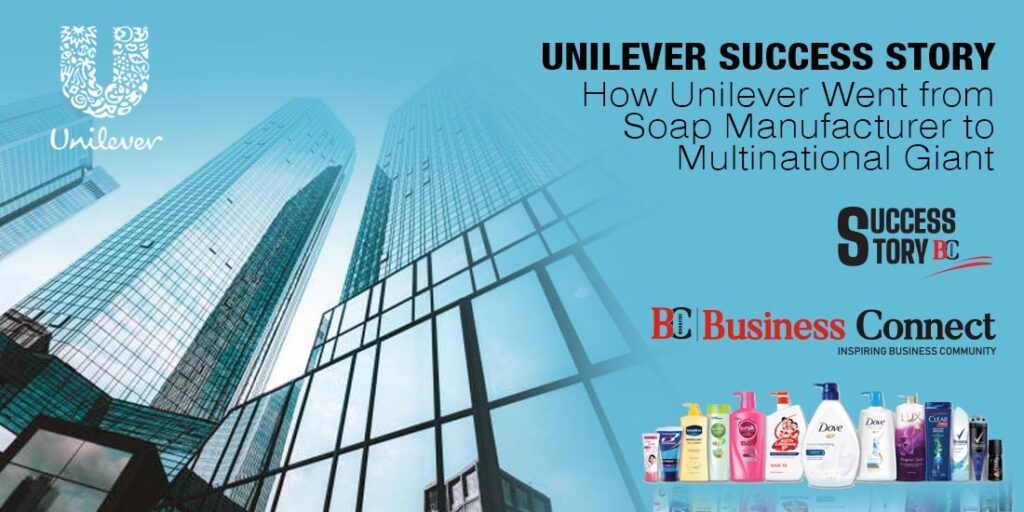Unilever Success Story: How Unilever Went from Soap Manufacturer to Multinational Giant
The consumer goods company Unilever is a British multinational which has its headquarter in London, England. Unilever manufactures daily needs products which include food, sauces, ice cream, cleaning supplies, cosmetics, and personal care items. Unilever products are sold around 190 nations which makes it world’s largest manufacturer of consumer goods.
Unilever’s portfolio includes some of the best-known and most loved brands such as Dove, Knorr, Lipton, and Hellmann’s. Personal care, which brought in roughly 21.9 billion euros in revenue in 2021, is the Unilever Group’s largest product category. In that year, the group as a whole disclosed sales of almost 52.44 billion euros.
In this article, while exploring some of the company’s most successful brands and marketing campaigns, we trace Unilever’s journey from a small soap maker to the multinational giant it is today. Read on!
The Early Days of Unilever
Unilever was founded in the late 19th century and has since become one of the world’s leading multinational corporations. The company began as a soap manufacturer and has since expanded into areas such as food, home care, and personal care products.
Unilever has a long history of innovation, starting with the development of new soap recipes in the early days of the company. One of Unilever’s first major innovations was the introduction of sunlight soap, which was made using a new process that allowed for a higher quality product than previously available. Unilever also pioneered the use of vegetable oils in soapmaking, which led to the development of many popular brands such as Dove and Pears.
In addition to its soap businesses, Unilever also built up a successful food business starting in the early 1900s. The company acquired several well-known brands, such as Hellmann’s mayonnaise and Knorr soups. Unilever also developed new products such as Flora margarine and Lipton tea. Over the years, Unilever has continued to grow through both internal expansion and strategic acquisitions. Today, the company is a leading player in many different markets around the world.
The company’s transformation
In the late 1800s, Unilever was founded as a soap manufacturer in the United Kingdom. The company’s transformation began in the early 1900s when it started to expand its product range beyond soap. By the mid-1900s, Unilever had become a multinational giant, with products ranging from food to detergents. Today, Unilever is a household name, with products sold in over 190 countries around the world. The company has managed to adapt and change with the times, while still maintaining its core values. Unilever is a great example of how a company can grow and succeed on a global scale.
Unilever’s products and brands
Unilever is one of the world’s largest consumer goods companies with a portfolio that includes some of the most recognizable brands in the world. Unilever’s products are divided into four main categories: food, home care, personal care, and refreshment. Some of Unilever’s best-known brands include Lipton, Knorr, Hellmann’s, Dove, Omo/Surf, Ben & Jerry’s, Lifebuoy, Sunsilk, Lux, Sunlight, Rexona/Degree, Axe/Lynx, Omo/Persil, Heartbrand (Wall’s) ice creams, Hellmann’s, and Magnum.
How Unilever has succeeded
There are several factors that have contributed to Unilever’s success. Firstly, the company has diversified its product range significantly over the years. While it started out as a soap manufacturer, it now sells a wide range of food, home care, and personal care products. This has helped it to tap into different markets and grow its customer base.
Secondly, Unilever has made strategic acquisitions of other companies over the years which have helped to boost its growth. Some notable examples include the acquisition of Best Foods in 2000 and Dove in 2007. These acquisitions have allowed Unilever to enter new markets and gain access to new technologies and capabilities.
Thirdly, Unilever has invested heavily in marketing and advertising over the years. This has helped it to build strong brand equity for its products and create a loyal customer base. Some iconic advertising campaigns that have been run by Unilever include ‘Surf Excel’, ‘Dove’, and ‘Lipton’. Fourthly, Unilever has adopted an aggressive expansion strategy which has seen it enter new markets and set up operations in countries all over the world.
The future of Unilever
Today, Unilever sells its products in more than 190 countries and employs over 172,000 people. Looking to the future, Unilever has set itself some ambitious goals. It wants to double its size while reducing its environmental impact and increasing its positive social impact. This means growing its business in a sustainable way that benefits both people and the planet. To achieve these goals, Unilever is investing in innovation and technology. It is also working to build closer relationships with its customers and communities. These efforts will help Unilever continue to thrive in the years to come.
Final Words
From its humble beginnings as a soap manufacturer, Unilever has grown into a multinational giant, with operations in over 190 countries and products sold in over 170 of them. The company has achieved this through a combination of organic growth and astute acquisitions, and its portfolio today includes some of the world’s most iconic brands. Unilever is a true success story, and its journey from small-scale manufacturer to global powerhouse is an inspiration to businesses everywhere.



